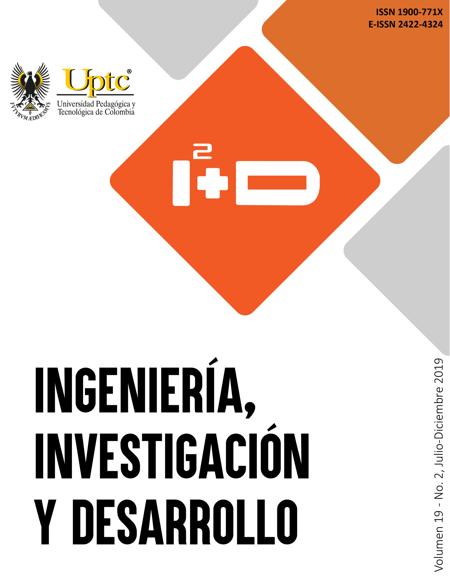Characterization of the logistical capacities in the strawberry producing agricultural associations in the municipalities of Soacha and Sibaté

Abstract
Agricultural logistics in Colombia faces great challenges, due, among other factors, to the low investment in the sector, the high level of intermediation in the agri-food supply chain, which causes a decrease in the monetary amount received by producers and a high price paid by the final consumer, and to factors such as low associativity, added to the poor organization and lack of capacities or capabilities of the existing associations. Within these capacities is the technical assistance required by the associates and the means for the commercialization of their products. They are not having the necessary capacities, for this reason, losses are generated in producers, as they do not receive adequate remuneration for their crops. This discourages production and impairs the quality of life of farmers. Therefore, it is proposed to carry out an analysis to strengthen the logistics capacities and capabilities of strawberry producing associations, from two approaches. The first one refers to physical capacities, oriented to means such as transportation, facilities and technological means of information and traceability. The second one includes capabilities in the form of logistics modes, encompassing three fundamental processes: provisioning, storage and inventory, and distribution. For the analysis of this situation, strawberry producers belonging to agricultural associations in the municipalities of Soacha and Sibaté, the main producers of this fruit at the national level, are established as a study focus. The study methodology will be developed from a pragmatic approach, with the use of mixed strategies, through surveys and semi-structured interviews as instruments for collecting primary information.
Keywords
associativity, agri-food supply chains, logistics capabilities, agricultural logistics
References
[1] P. C. O. Vélez, (2013). Gerencia logística y global. Revista EAN. [Online]. https://doi.org/10.21158/01208160.N66.2009.477
[2] R. H. Ballou. "Logística Administración de la cadena de suministro", Vol 5, 2004.
[3] S. Chopra. " Administración de la cadena de suministro", Vol 3, 2008.
[4] V. Islas, & M. Lelis, (2007). Análisis de los Sistemas de Transporte: Conceptos básicos. 1(Publicación técnica No. 307), 75. [Online]. http://www.imt.mx/archivos/publicaciones/publicaciontecnica/pt307.pdf
[5] G. R. Roncancio & G. C. Sáenz, (2016). Propuesta de un modelo asociativo para los productores agrícolas de puente nacional Santander mediante el diseño de un centro de acopio de productos agrícolas de la región para el mejoramiento de las condiciones económicas y sociales de sus asociados. IOSR Journal of Economics and Finance. [Online]. https://doi.org/https://doi.org/10.3929/ethz-b-000238666
[6] M. M. Herrera, & J. A.Orjuela Castro, " Perspectiva de trazabilidad en la cadena de suministros de frutas: un enfoque desde la dinámica de sistemas. Ingeniería", vol. 19 no. 2, pp. 63–84, 2014.
[7] J. Pérez, & M. Merino, (2014). Definición de Registro de datos. [Online]. https://definicion.de/registro-de-datos/
[8] D. Pérez, & I. Pérez, (2006). Marketing. El Producto. Concepto y Desarrollo. MBA- EOI Escuela de Negocios. [Online]. http://api.eoi.es/api_v1_dev.php/fedora/asset/eoi:45113/componente45111.pdf
[9] C. P. (2008) Hernández Sampieri, R., & Mendoza, “El matrimonio cuantitativo cualitativo: el paradigma mixto.,” J. L. Álvarez Gayou (Presidente), 6o Congr. Investig. en Sexol. Congr. efectuado por el Inst. Mex. Sexol. A. C. y la Univ. Juárez Autónoma Tabasco, Villahermosa, Tabasco, México., 2008.
[10] J. P. Loaiza and L. F. Rojas, “Metodología para la construcción de instrumentos en la caracterización de cadenas productivas. Caso de estudio: Aguacate Hass y Caña Panelera en Cauca-Colombia. Conference Paper.,” in Congreso internacional industria y organizaciones CIIO, 2018.
[11] H. Bello, “Entrevista,” 2019.
[12] A. Quiroga, “Entrevista,” 2019.
[13] “Guía de observación trabajo de campo,” 2019.
[14] C. Pinzón, “Acuerdo No . 11 de 2002 por medio del cual se modifica , ajusta y adecua el acuerdo No . 10 de 2002 mediante el cual se adopto el plan básico de ordenamiento territorial del cual se realiza una revisión excepcional al plan básico de ordenamiento territorial,” no. 11, 2010.
[15] M. Rojas and J. Barbosa, “Entrevista,” 2019.
[16] D. M. Gligor and M. C. Holcomb, “Understanding the role of logistics capabilities in achieving supply chain agility: A systematic literature review,” Supply Chain Management, vol. 17, no. 4. pp. 438–453, 2012.
[17] K and Wajszczuk, “The Role and Importance of Logistics in Agri-Food Supply Chains: An Overview of Empirical Findings,” Logist. Transp., vol. 2, no. 30, pp. 47–56, 2016.
[18] B. Salazar, “Gestión de almacenes.” [Online]. Available: https://logisticayabastecimiento.jimdo.com/almacenamiento/.
[19] A. Cardona and M. Granados, La logística del transporte: un elemento estratégico en el desarrollo agroindustrial. 2007.
[20] Fondo Social Europeo, “Planificación de las instalaciones (Plan Operativo) en Proyectos de negocio,” 2012.
[21] V. M. Narasalagi, “Building Sustainable Organizational Capabilities through Supply Chain Innovation,” Eur. J. Logist. Purch. Supply Chain Manag., vol. 3, no. 3, pp. 25–34, 2015.